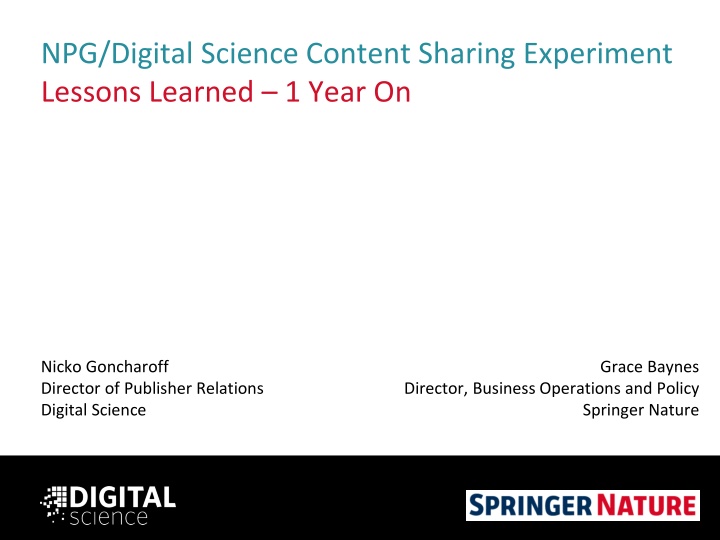
Lessons Learned from NPG/Digital Science Content Sharing Experiment
Explore the insights and outcomes from a year-long experiment on content sharing by NPG and Digital Science. Discover the challenges, solutions, and opportunities identified in facilitating effective content sharing in the digital age.
Download Presentation

Please find below an Image/Link to download the presentation.
The content on the website is provided AS IS for your information and personal use only. It may not be sold, licensed, or shared on other websites without obtaining consent from the author. If you encounter any issues during the download, it is possible that the publisher has removed the file from their server.
You are allowed to download the files provided on this website for personal or commercial use, subject to the condition that they are used lawfully. All files are the property of their respective owners.
The content on the website is provided AS IS for your information and personal use only. It may not be sold, licensed, or shared on other websites without obtaining consent from the author.
E N D
Presentation Transcript
NPG/Digital Science Content Sharing Experiment Lessons Learned 1 Year On Nicko Goncharoff Director of Publisher Relations Digital Science Grace Baynes Director, Business Operations and Policy Springer Nature
Starting point: the problem we sought to solve Scientists have always shared their work helping them do so is central to Nature s mission It s what the WWW was invented for and researchers in their millions are now taking full advantage SO WHAT? Tools are sub-optimal (Dropbox; I can haz PDF) It s a black box: for publishers/libraries It creates conflict: take-down notices = reputational damage
Why Now? Scope of sharing expanding rapidly with internet tools and networks Authors want better tools for sharing their work Being passive did not seem a viable approach An experiment was the only way to learn how to best facilitate sharing and measure opportunities and risks
Experiment Partners Dec 2014 Had the components (content, technology, policy) to take this first step, learn, and share results Has duty to readers and authors to facilitate sharing that benefits research and is commercially viable Opportunity for ReadCube to better serve researcher, institutional, and publisher customers
Our approach. Nature wanted to: Encourage sharing: on its own platform (nature.com); then on 3rd party platforms Find solutions to making sharing COUNTER-compliant Understand usage & need Provide data and experience to inform constructive discussion & solutions across the industry
NPG Content/Policy + Digital Science Technology ReadCube Connect Enhanced PDF technology 49 NPG Journal Full Text Articles Shareable read-only, full- text articles on nature.com
Sharing Methods Peer-to-Peer Subscribers send or post shareable links to NPG journal article on nature.com Media Referral Readers access full- text journal articles on nature.com cited on 100 trusted news and blog sites
Parameters Two types of sharing Peer-to-peer Media referral Read-only access to full text articles on nature.com Use results and feedback to evolve sharing features, policy and commercial models Share results with research and publisher communities Supported by a beta policy and T&C s 12-month pilot (but expect it to be long-term)
Sharing Statistics Dec 2 2014-Nov 30 2015 Commentary About 815K shared views during period 8% 15% Most (~630K) views are referrals from whitelist media sites 77% Of ~184K Peer-to-Peer shares: 67% (123K) subscribers to non- subscribers 33% (61K) subscriber- subscriber or OA content Media Referral Peer-to-Peer (Non-subscriber) Peer-to-Peer (Subscriber/OA)
Sharing Activity - Top Five Country Journal Media
Conclusions Steady usage, but modest numbers Do we need to better promote among researchers? Bulk of views are media referrals Activity influenced by news events Coverage of major Nature papers causes spikes in views Media referral fits into reader workflow; peer-to-peer sharing possibly less so P2P sharing is mostly between subscribers and non-subscribers, with the remainder often between two people who already have access No downturn in single-article sales Little to no instances of abuse observed
What we learnt from the community response Some good... Lots of media & social media interest Generally positive Some bad... Open Access: misunderstood as a move away from gold/green OA by some DRM: consternation & concerns
Whats Next? Springer Nature to continue offering on-platform sharing Will look at ways to expand services to authors and readers Beta policy extended Springer Nature & Digital Science to continue supporting STM content sharing policy efforts Includes participation in article tagging sub-group tasked with developing prototype to enable public sharing across multiple publishers and platforms On-platform article sharing now a part of ReadCube s Connect Enhanced PDF product
